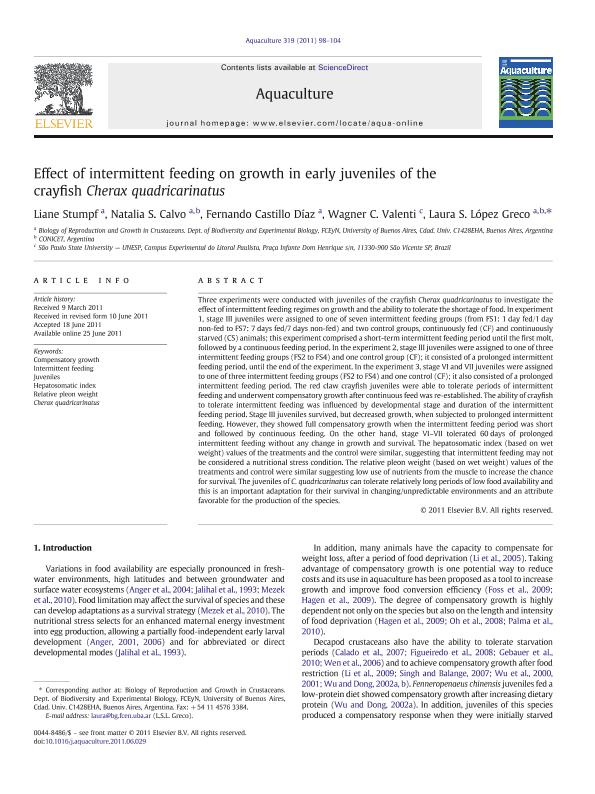Mostrar el registro sencillo del ítem
dc.contributor.author
Stumpf, Liane

dc.contributor.author
Calvo, Natalia Soledad

dc.contributor.author
Castillo Díaz, Fernando

dc.contributor.author
Valenti, Wagner C.

dc.contributor.author
Lopez, Laura Susana

dc.date.available
2019-01-02T20:50:30Z
dc.date.issued
2011-09
dc.identifier.citation
Stumpf, Liane; Calvo, Natalia Soledad; Castillo Díaz, Fernando; Valenti, Wagner C.; Lopez, Laura Susana; Effect of intermittent feeding on growth in early juveniles of the crayfish Cherax quadricarinatus; Elsevier Science; Aquaculture; 319; 1-2; 9-2011; 98-104
dc.identifier.issn
0044-8486
dc.identifier.uri
http://hdl.handle.net/11336/67254
dc.description.abstract
Three experiments were conducted with juveniles of the crayfish Cherax quadricarinatus to investigate the effect of intermittent feeding regimes on growth and the ability to tolerate the shortage of food. In experiment 1, stage III juveniles were assigned to one of seven intermittent feeding groups (from FS1: 1. day fed/1. day non-fed to FS7: 7. days fed/7. days non-fed) and two control groups, continuously fed (CF) and continuously starved (CS) animals; this experiment comprised a short-term intermittent feeding period until the first molt, followed by a continuous feeding period. In the experiment 2, stage III juveniles were assigned to one of three intermittent feeding groups (FS2 to FS4) and one control group (CF); it consisted of a prolonged intermittent feeding period, until the end of the experiment. In the experiment 3, stage VI and VII juveniles were assigned to one of three intermittent feeding groups (FS2 to FS4) and one control (CF); it also consisted of a prolonged intermittent feeding period. The red claw crayfish juveniles were able to tolerate periods of intermittent feeding and underwent compensatory growth after continuous feed was re-established. The ability of crayfish to tolerate intermittent feeding was influenced by developmental stage and duration of the intermittent feeding period. Stage III juveniles survived, but decreased growth, when subjected to prolonged intermittent feeding. However, they showed full compensatory growth when the intermittent feeding period was short and followed by continuous feeding. On the other hand, stage VI-VII tolerated 60. days of prolonged intermittent feeding without any change in growth and survival. The hepatosomatic index (based on wet weight) values of the treatments and the control were similar, suggesting that intermittent feeding may not be considered a nutritional stress condition. The relative pleon weight (based on wet weight) values of the treatments and control were similar suggesting low use of nutrients from the muscle to increase the chance for survival. The juveniles of C. quadricarinatus can tolerate relatively long periods of low food availability and this is an important adaptation for their survival in changing/unpredictable environments and an attribute favorable for the production of the species. © 2011 Elsevier B.V.
dc.format
application/pdf
dc.language.iso
eng
dc.publisher
Elsevier Science

dc.rights
info:eu-repo/semantics/openAccess
dc.rights.uri
https://creativecommons.org/licenses/by-nc-sa/2.5/ar/
dc.subject
Cherax Quadricarinatus
dc.subject
Compensatory Growth
dc.subject
Hepatosomatic Index
dc.subject
Intermittent Feeding
dc.subject
Juveniles
dc.subject
Relative Pleon Weight
dc.subject.classification
Agricultura

dc.subject.classification
Agricultura, Silvicultura y Pesca

dc.subject.classification
CIENCIAS AGRÍCOLAS

dc.title
Effect of intermittent feeding on growth in early juveniles of the crayfish Cherax quadricarinatus
dc.type
info:eu-repo/semantics/article
dc.type
info:ar-repo/semantics/artículo
dc.type
info:eu-repo/semantics/publishedVersion
dc.date.updated
2019-01-02T18:20:50Z
dc.journal.volume
319
dc.journal.number
1-2
dc.journal.pagination
98-104
dc.journal.pais
Países Bajos

dc.journal.ciudad
Amsterdam
dc.description.fil
Fil: Stumpf, Liane. Consejo Nacional de Investigaciones Científicas y Técnicas; Argentina. Universidad de Buenos Aires. Facultad de Ciencias Exactas y Naturales. Departamento de Biodiversidad y Biología Experimental. Laboratorio de Biología de la Reproducción y Crecimiento de Crustáceos Decápodos; Argentina
dc.description.fil
Fil: Calvo, Natalia Soledad. Consejo Nacional de Investigaciones Científicas y Técnicas; Argentina. Universidad de Buenos Aires. Facultad de Ciencias Exactas y Naturales. Departamento de Biodiversidad y Biología Experimental. Laboratorio de Biología de la Reproducción y Crecimiento de Crustáceos Decápodos; Argentina
dc.description.fil
Fil: Castillo Díaz, Fernando. Consejo Nacional de Investigaciones Científicas y Técnicas; Argentina. Universidad de Buenos Aires. Facultad de Ciencias Exactas y Naturales. Departamento de Biodiversidad y Biología Experimental. Laboratorio de Biología de la Reproducción y Crecimiento de Crustáceos Decápodos; Argentina
dc.description.fil
Fil: Valenti, Wagner C.. Universidade de Sao Paulo; Brasil
dc.description.fil
Fil: Lopez, Laura Susana. Consejo Nacional de Investigaciones Científicas y Técnicas; Argentina. Universidad de Buenos Aires. Facultad de Ciencias Exactas y Naturales. Departamento de Biodiversidad y Biología Experimental. Laboratorio de Biología de la Reproducción y Crecimiento de Crustáceos Decápodos; Argentina
dc.journal.title
Aquaculture

dc.relation.alternativeid
info:eu-repo/semantics/altIdentifier/url/https://www.sciencedirect.com/science/article/pii/S0044848611005096
dc.relation.alternativeid
info:eu-repo/semantics/altIdentifier/doi/https://doi.org/10.1016/j.aquaculture.2011.06.029
Archivos asociados
